Big Agnes Copper Spur Ul 1 Mtnglo Review
Large Agnes Copper Spur HV UL2
Cost: $450
Packaged weight: 3 lbs. 1 oz. (2P)
Floor area: 29 sq. ft.
Capacities: 1P, 2P, 3P, 4P
What we similar: Standout combination of livability, weight, and ease of use.
What nosotros don't: Thin materials and high toll.
Meet the Large Agnes Copper Spur HV UL2
Showtime introduced in 2008, the Copper Spur series by Big Agnes has been a consequent frontrunner in the ultralight tent category. Lightly updated last year, we tested the latest two-person model on a series of backpacking trips in Patagonia. All told, the high-quality build, competitive weight, 2-door-and-vestibule layout, and open up interior make information technology one of the near complete backpacking tents on the market. Below we break down our experiences with the legendary Copper Spur. To run across how it stacks upwards to the competition, run across our commodity on the best backpacking tents.
Table of Contents
- Weight and Packed Size
- Livability and Interior Space
- Durability
- Atmospheric condition Protection
- Ventilation
- Vestibules and Storage
- Fix and Have Downward
- What Nosotros Like/What We Don't
- Comparison Table
- The Competition
Operation
Weight and Packed Size
On our scale, the Big Agnes Copper Spur HV UL2 has a total packaged weight of 3 pounds 1 ounce (merely nether its 3 lbs. 2 oz. listed weight). While technically 1 ounce heavier than the prior version, it's notwithstanding in pretty elite visitor: among lightweight freestanding models, the pop Nemo Dagger 2P and MSR Hubba Hubba NX (both three lbs. 14 oz.) are quite a bit heavier. The tent does fall short of ultralight designs like Nemo's Hornet (2 lbs. half-dozen oz.) and Big Agnes' own Fly Creek HV UL2 (2 lbs. 4 oz.) and Tiger Wall UL2 (2 lbs. 8 oz.), only these tents compromise large time in terms of interior infinite and only have semi-freestanding builds that aren't as easy or quick to pitch. For its combination of space, convenience, and features, the Copper Spur'southward weight is fantastic.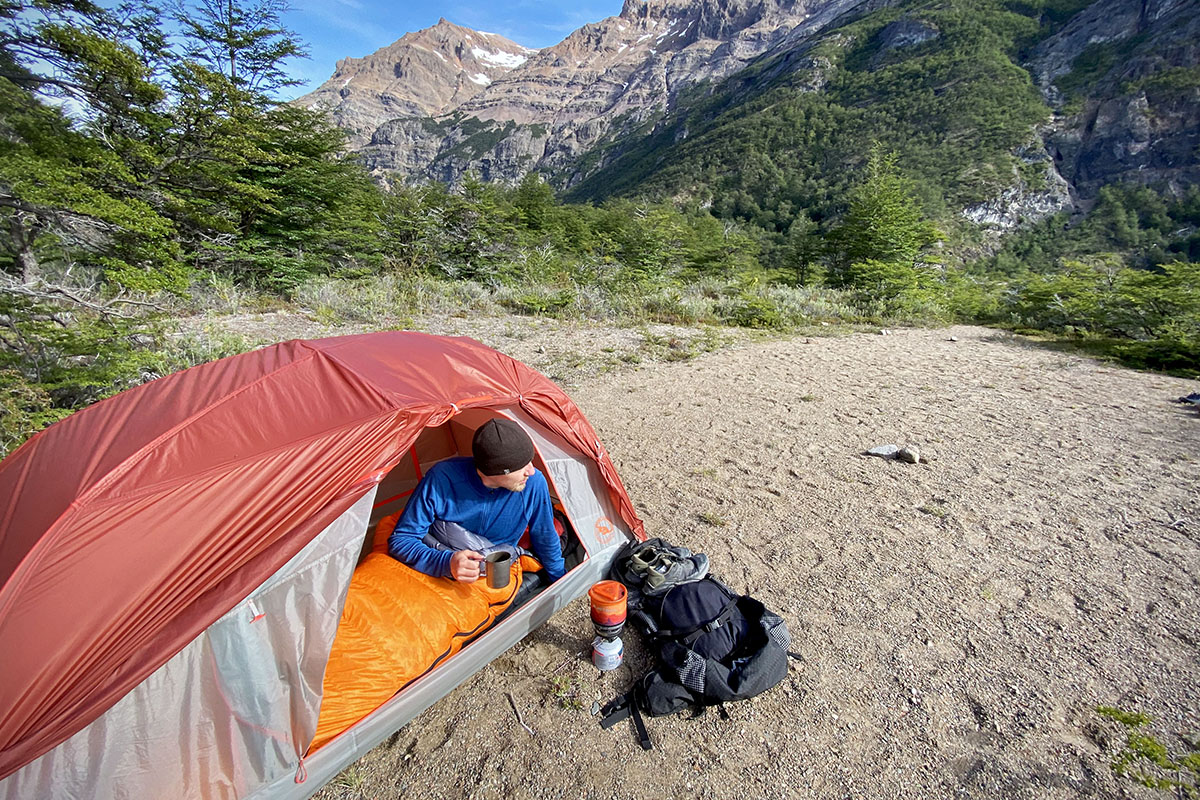
Every bit far as packability goes, the tent stuffs down to half-dozen ten 19.5 inches, which amounts to a small increase in diameter compared to the prior generation (length remains the same). Importantly, it even so fits nicely into its stuff sack, and we've had no issues squeezing it into our backpacking packs. And the Copper Spur is still plenty competitive in the market, undercutting the REI Co-op Quarter Dome SL two (7 x xx in.) and Nemo Dagger 2P (vi.5 10 nineteen.five in.), while coming up a little brusque of the Tiger Wall UL2 (5.v x 18 in.). Merely if space is a concern, you lot tin can ever split the pole purse from the rest of the tent, every bit its pre-bent sections and hubbed system are responsible for a lot of the bulk.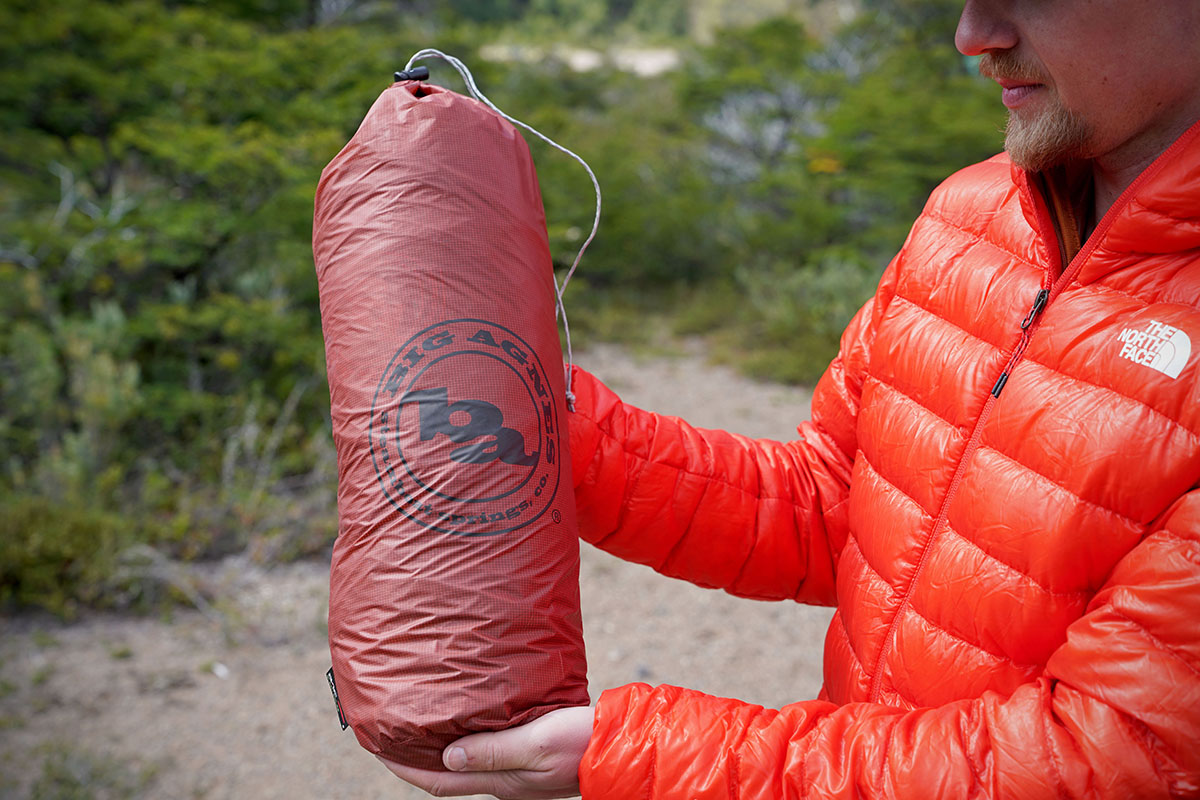
Livability and Interior Space
Now in its second generation, the Copper Spur's HV (for "high-book") pole structure offers standout livability. The fully freestanding construction keeps the tent body taut even when camping on difficult surfaces like stone, and Big Agnes further additional interior space with pre-bent pole sections at each corner. Getting into the tent, the open feeling is immediately apparent: the interior is virtually rectangular thanks to the near-vertical side walls and large, flat roof. Peak height is reasonably tall at 40 inches, and the crisscrossing pole construction makes it easy for two people to sit down up side by side. It's truthful that the tent tiptop drops towards the foot cease, but even that space is fairly generous. All told, the pole arrangement may increment weight a little, but if you'll be consistently camping with a partner, nosotros remember the tradeoff in roominess is well worth information technology.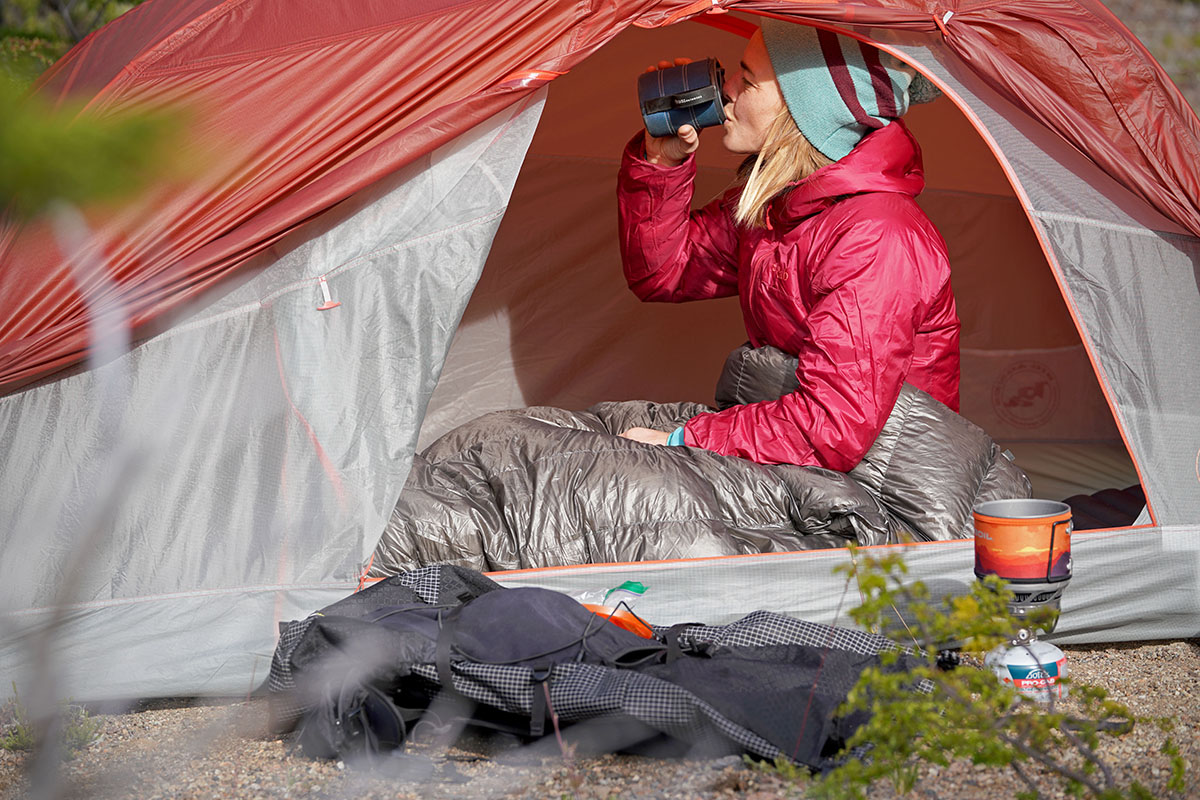
The pole design accomplishes its goal of maximizing interior volume, but it'south of import to note that the tent'due south footprint even so is relatively small. The Copper Spur measures 52 inches broad at the caput end of the tent and a tapered 42 inches at the feet, and its actual widths are a couple inches less for each (this is common among tents). As a effect, y'all can only slumber with your head at one end. In addition, if you lot are sharing the space with a partner, it's best to use a mummy-shaped sleeping pad to maximize room at the foot end. With this layout, it'due south possible to clasp one wide 25-inch pad aslope a regular 20-inch pad without any overlap (two broad pads could be tricky to pull off).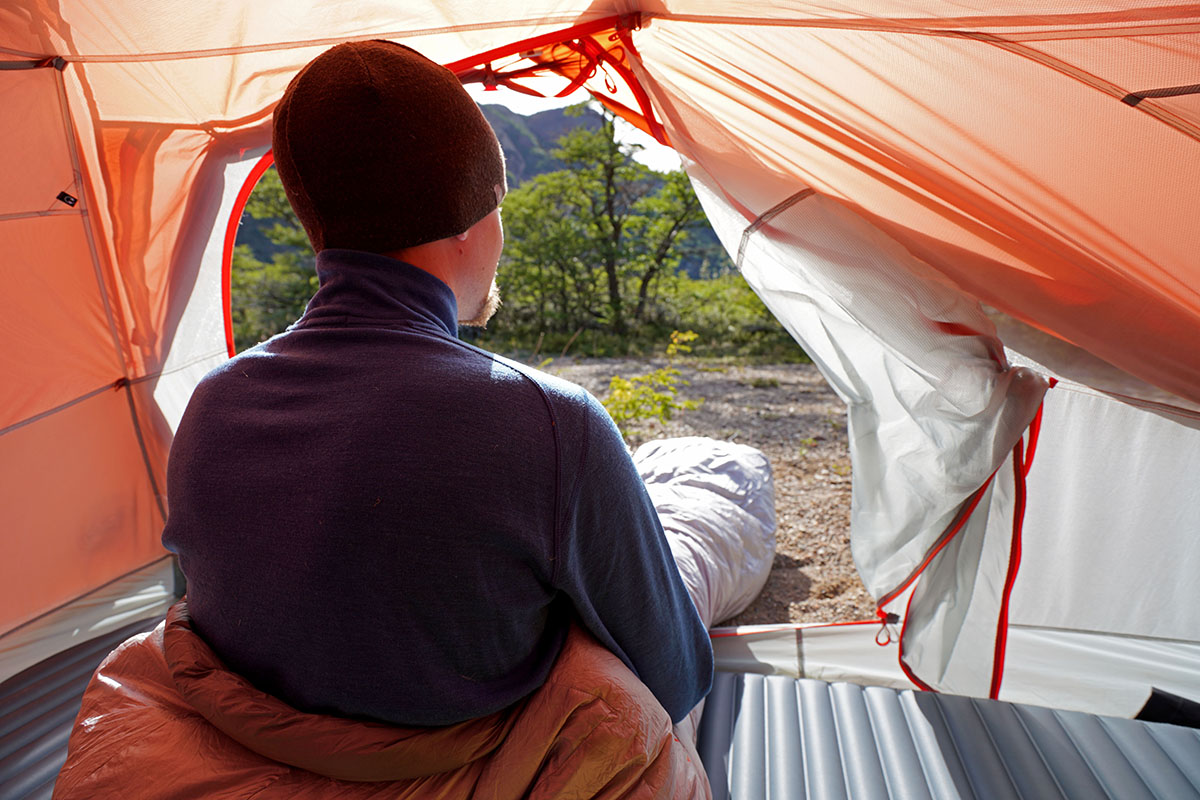
Durability
Cut weight from a tent commonly involves utilizing sparse and delicate materials, and the Copper Spur HV UL2 is no exception. Denier (D) commonly is used to measure out material thickness (information technology actually is the fabric yarn's weight), and this Big Agnes tent has lightweight and low-denier fabrics throughout. The floor, rainfly, and solid fabric portion of the tent body use a mixed 15D x 20D nylon, and the mesh on the tent torso is besides quite thin at 15D. For comparison, the MSR Hubba Hubba NX has a 30D floor for a modest increase in durability (and weight) in the area most likely to go a tear. There are even lower-denier fabrics on the market, including Nemo's Hornet and REI Co-op's Flash Air tents, which have 15D nylon floors. We've found that these tents push our comfort level in terms of fabric thickness, but actress care is advisable for all modern lightweight tents.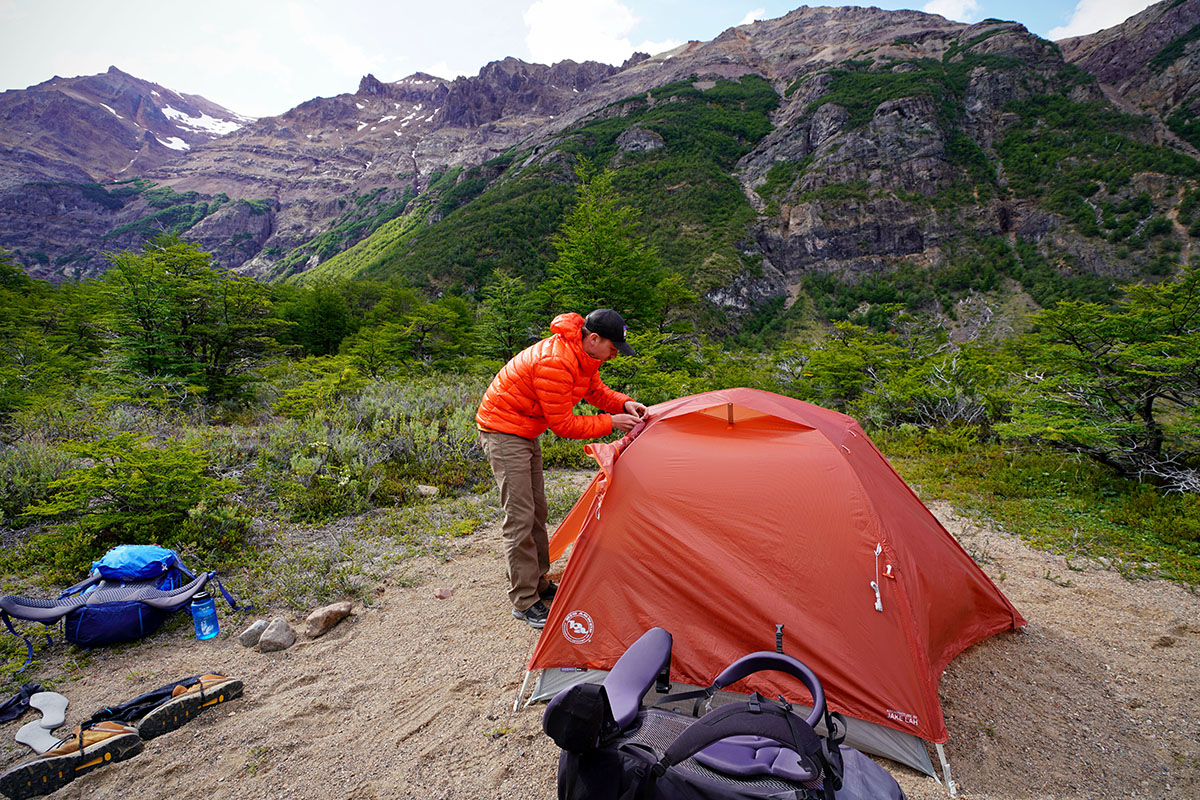
It's important to note that the denier measurement does not have into account various material technologies. Big Agnes uses a proprietary nylon in a unique double-ripstop weave on the floor and fly, with the more than substantial 20D sections offering increased tear forcefulness. In use, the fabrics are light and thin but accept a quality experience and are certainly zippo out of the ordinary in this category. In addition, information technology'southward worth noting that the zippers on the tent body and rainfly feel noticeably more substantial and trustworthy compared with the prior model. And most importantly, everything from the fabrics to the DAC poles and stakes are holding up very well afterwards two backpacking trips.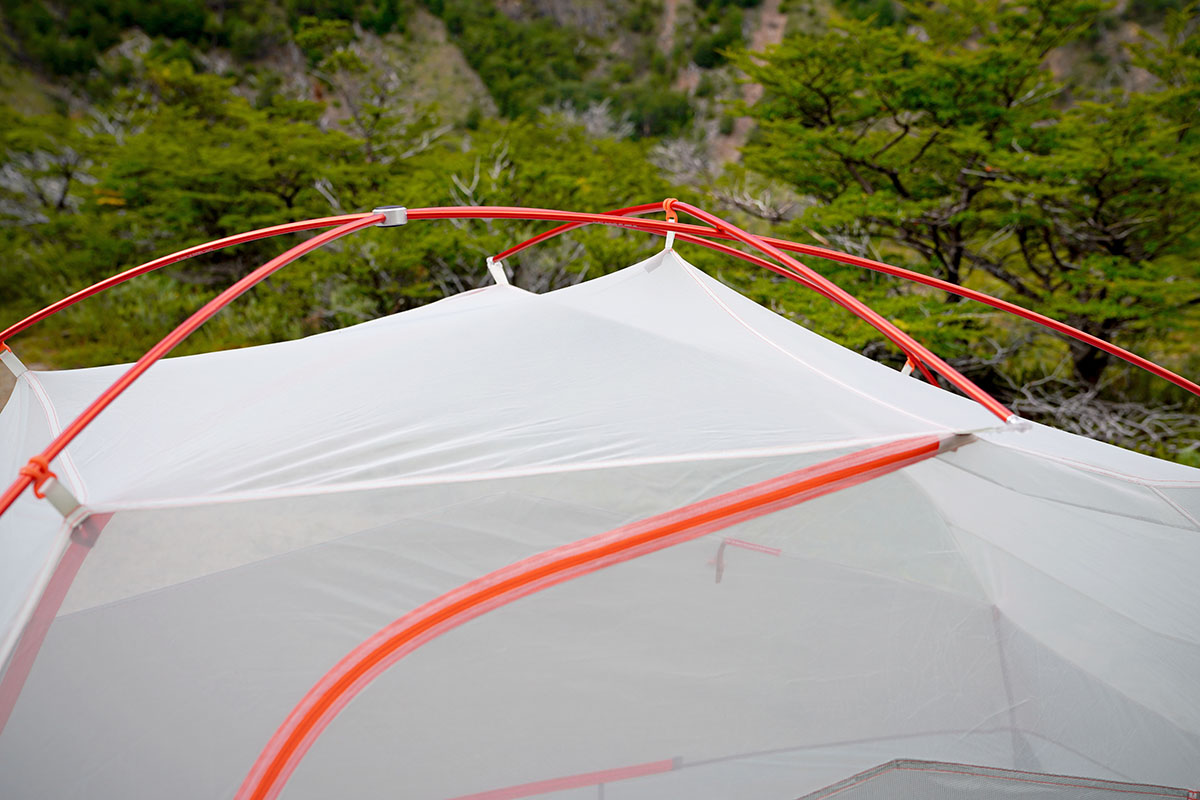
Atmospheric condition Protection
On our trip in Patagonia, our Copper Spur HV UL2 held stiff in conditions ranging from moderate current of air and blowing dust to a full night of rainfall. The taut, fully freestanding structure was very sturdy in gusty weather, and the full-coverage rainfly did a nice chore shedding persistent rain. Plus, the tent does a nice job blocking splashing h2o too as blowing grit thanks to a fly that sits depression to the ground and a tall bathtub floor. Big Agnes besides includes guyout points at each corner and guylines to further increase strength, although yous'll demand to bring forth extra stakes to utilize them. Like most 3-season tents, the Copper Spur is not built for fending off heavy snowfall, and it's best to pick protected campsites, but the tent has proven to be quite capable in nigh inclement atmospheric condition.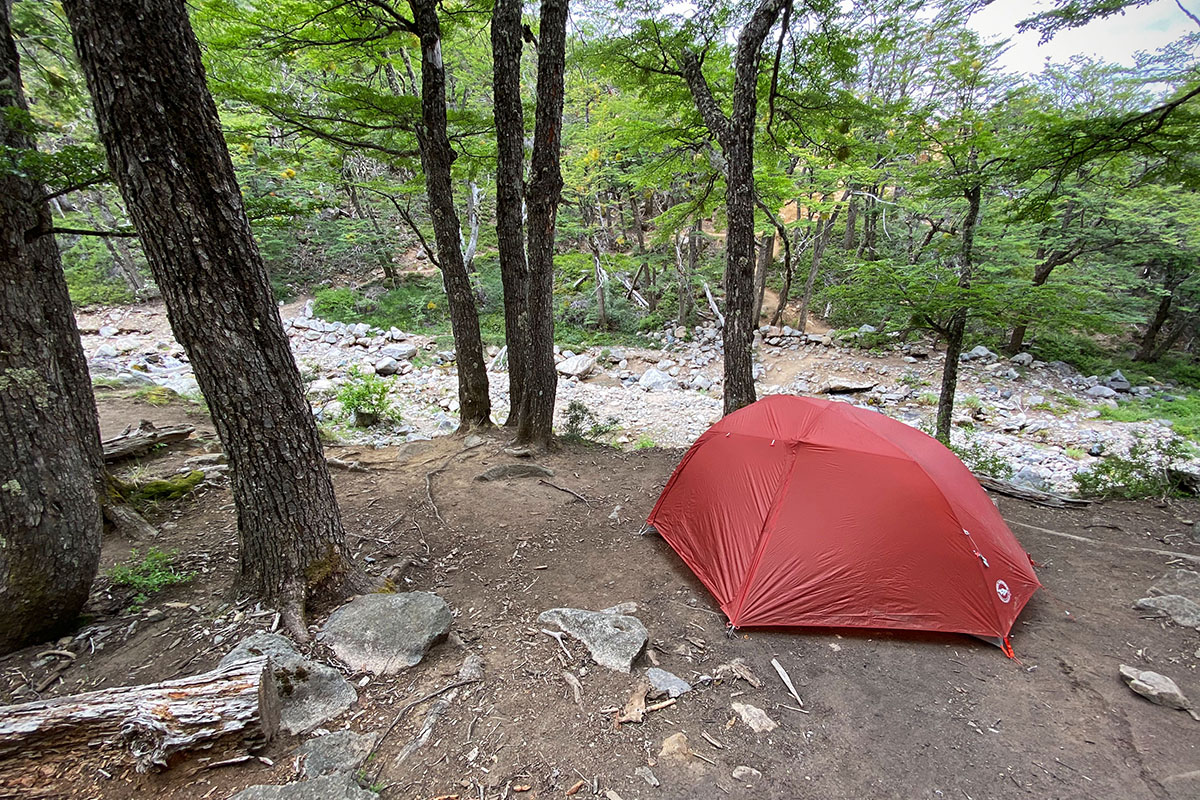
Ventilation
Liberal use of mesh on the tent body and a large, deployable vent at the superlative of the rainfly provide good all-around ventilation. And unlike some ultralight tents that utilise a single-wall structure, the double-wall build on the Copper Spur does a great chore keeping air moving and reduces the chance of condensation buildup. Importantly, in that location is good spacing between the rainfly and tent body to encourage airflow, including stakeout points on the rainfly at the head and foot ends. And if conditions are right, you tin can stake out the vestibules in an awning-like set-up to really boost ventilation (more on this below). In more than farthermost temperatures—we peaked in the mid 70s on our Patagonia trip—a second roof vent might be helpful for releasing hot air, but nosotros were reasonably comfortable even with the sun hit the tent in the late afternoon.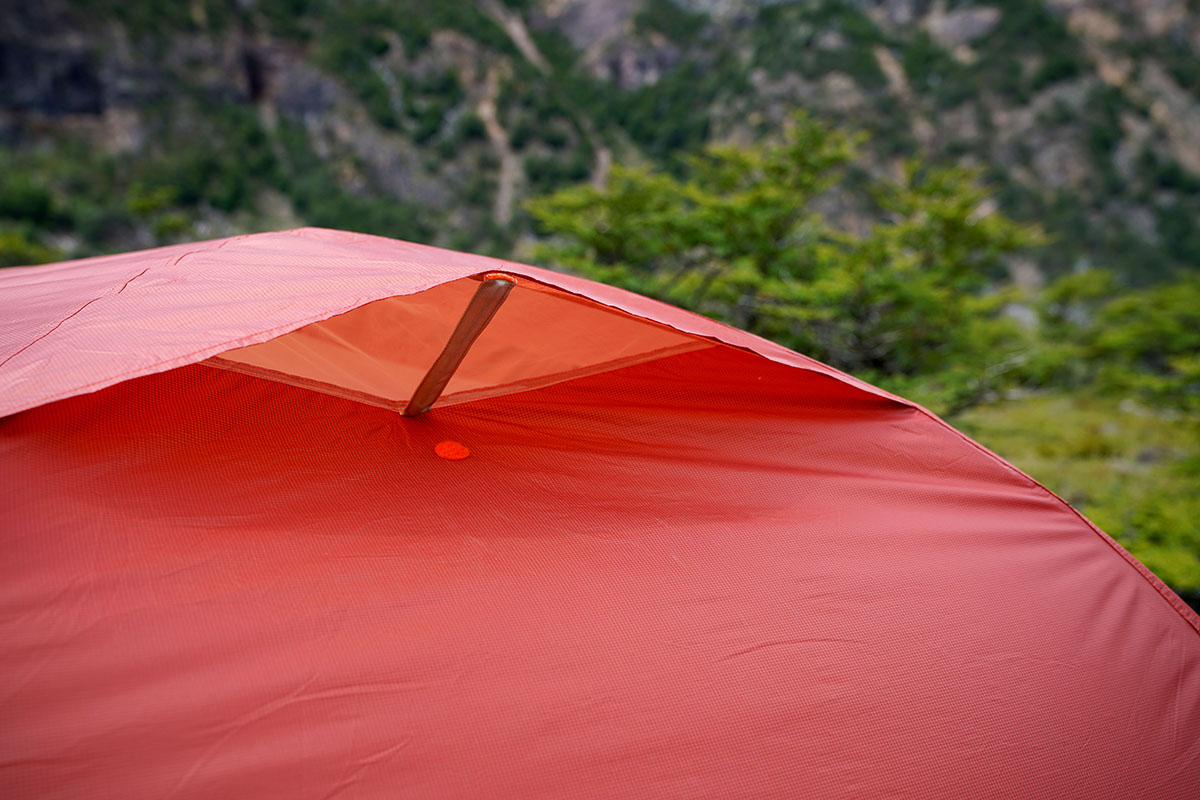
Vestibules and Storage
We really value the convenience that comes with a two-door-and-vestibule design. Being able to store gear on both sides, and non having to worry about crawling over your tentmate in the night, are well worth the extra ounces, in our opinion. The Copper Spur's two vestibules measure out 9 foursquare feet each, which is about average for a lightweight tent, and they are large enough to store a backpacking pack and shoes without tripping you lot on your way inside. Interior storage is excellent, with a long pocket built into the tent'due south roof on the head finish that easily stretches to conform something as wide as a headlamp, and there are ii small pockets at head meridian located only in front of the doors. Additionally, Big Agnes added a huge pocket on the human foot stop that stretches the full width of the tent. The open up, hanging mesh design has proven to exist very handy for stowing large items and drying out wet gear during the day.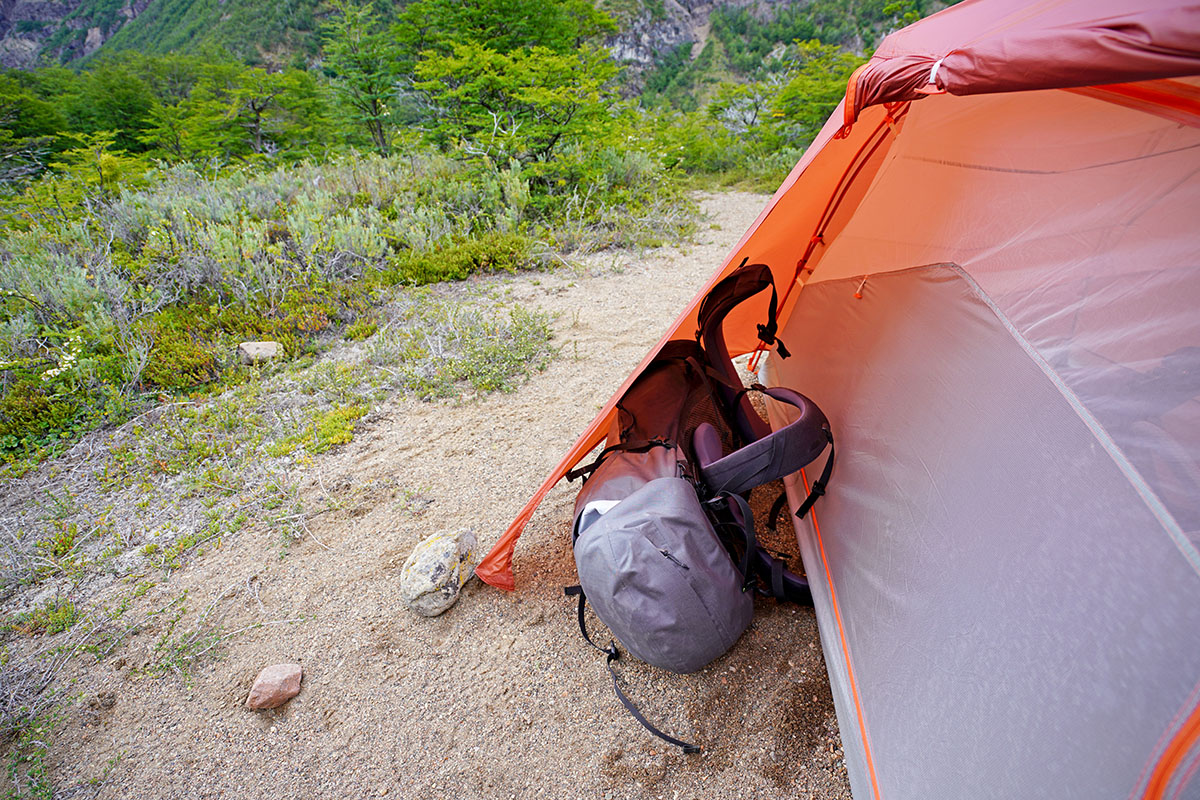
Along with the changes to the pocket layout, some other notable upgrade on the latest Copper Spur was a new, adaptable foyer. Big Agnes added a second zipper onto each vestibule, which allows yous to prop open up the doors for an canopy-like gear up-up. This requires trekking poles and using the included guylines (iv sets come up with the tent), merely it's a nice feature that increases airflow while retaining plenty of sun protection. Nosotros doubtable a skilful number of backpackers won't utilize the awning, simply the good news is that the second zipper on the anteroom as well makes it easier to apace access the interior door.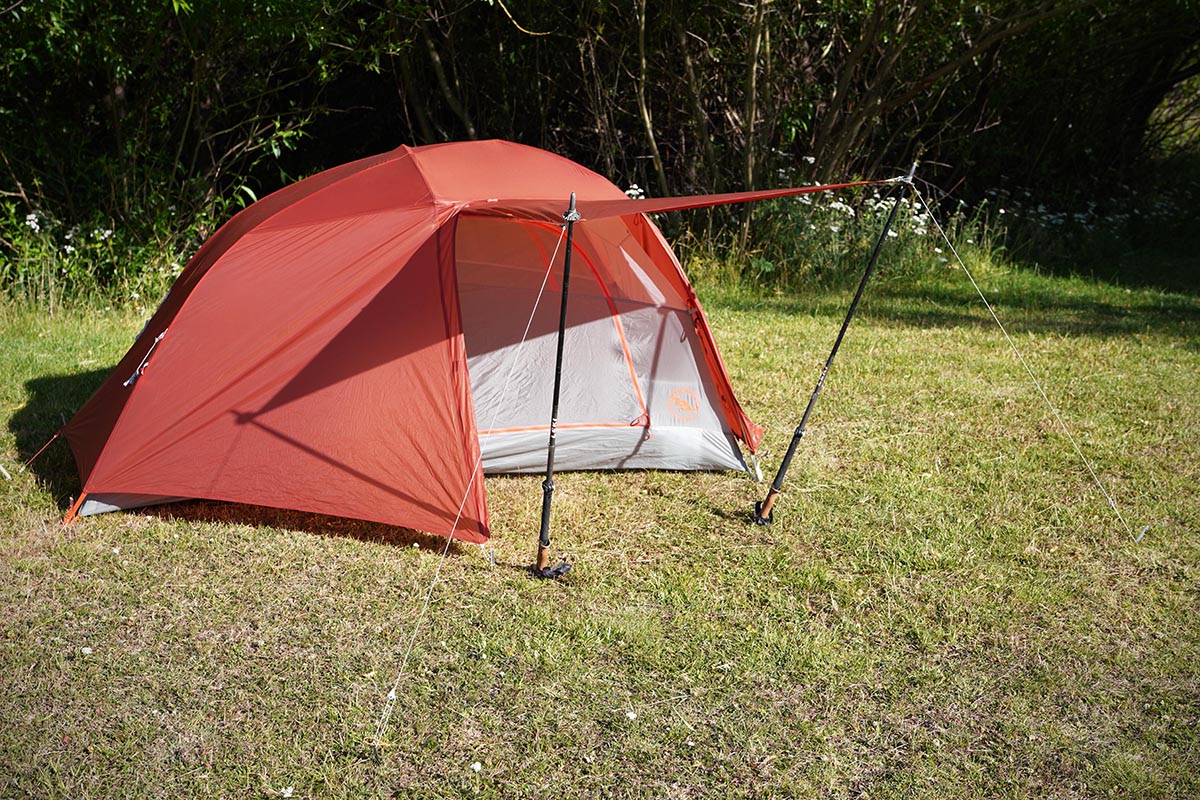
Prepare and Take Down
We had a range of non-freestanding and ultralight backpacking tents on our trip, and their finicky fix-up processes made us really capeesh the quick and logical blueprint of the Copper Spur. The freestanding build goes up easily past staking out the corners, inserting the poles into the colour-coordinated grommets on either terminate (the not-symmetrical shape means at that place is only one style to fix information technology up), and clipping in. The center hub creates the X-shaped structure, and a split up minor ridge pole connects at the top of each door. The wing goes on over the height, buckles conveniently at each corner, and can pulled taut with Velcro attachments for the poles and guylines on all sides. Unsurprisingly, tear-downwards is just equally quick and easy. The whole process didn't take more than than a few minutes even on the start try, and we besides found information technology relatively elementary to pitch in the wind.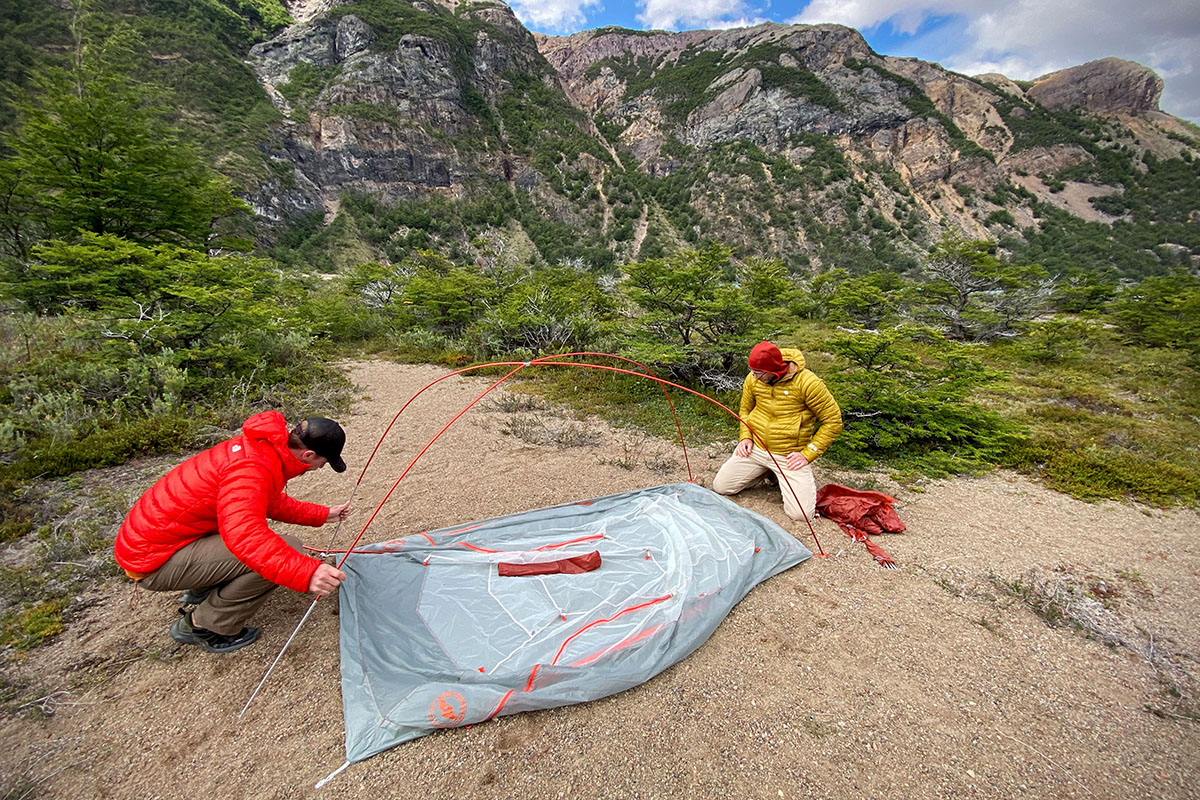
Other Capacities of the Big Agnes Copper Spur HV UL
We put the Copper Spur HV UL2 through its paces for this review, and Big Agnes likewise makes the same tent in i-, 3-, and four-person versions. The design remains largely the same across all three capacities, although the tents vary in weight, toll, interior and vestibule space, and elevation elevation. As nosotros touched on to a higher place, the 2P we tested struggled to fit two wide-width sleeping pads, so sizing up to the 3-person version (3 lbs. 14 oz. and $500) makes a lot of sense for those with a dog or who simply want added room to move effectually. Within the larger "HV" line, which all share the hubbed pole system, Big Agnes offers MTNGlo versions (1-3P) with congenital-in string lights, likewise as bikepack-specific models (ane-2P) with shortened pole segments and other specialized features for like shooting fish in a barrel on-the-go storage. There as well are lighter Platinum (two-3P) and beefed-upward, mountain-set up Expedition (two-3P) variations, both of which are more targeted options than the version tested here.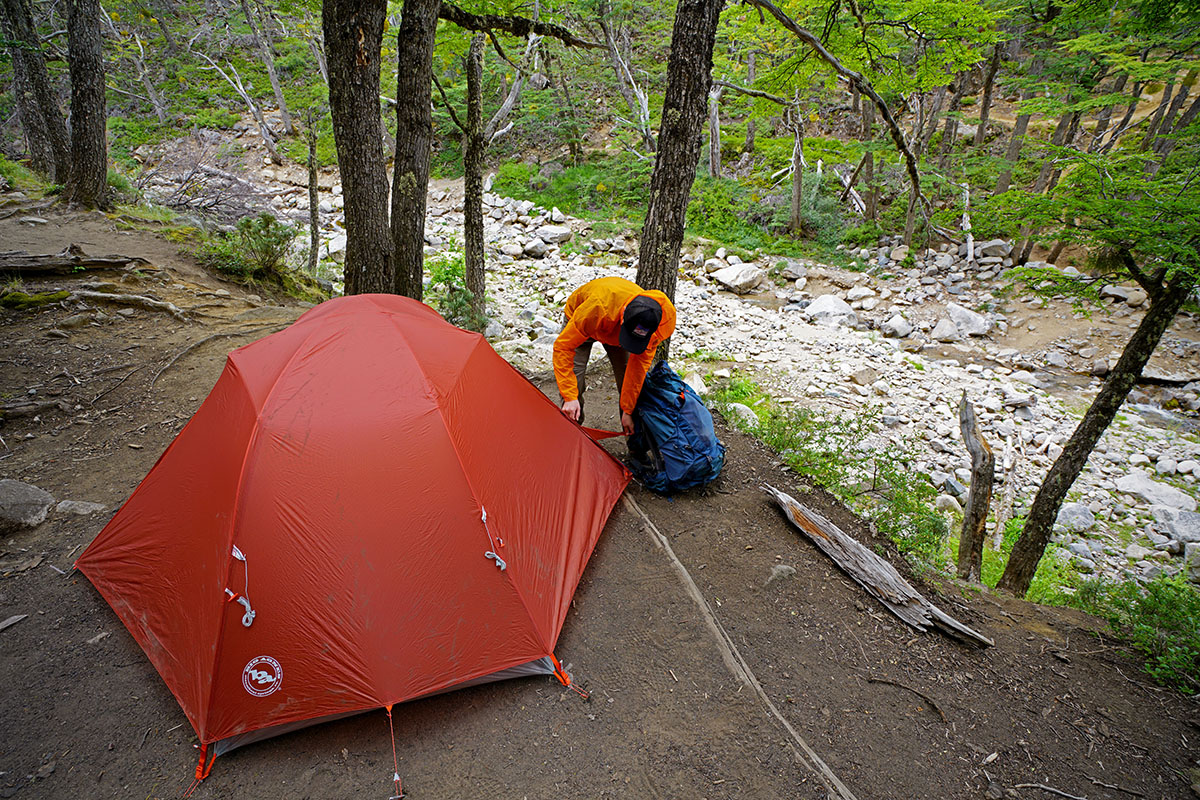
What We Like
- 4-fashion, loftier-volume pole pattern does a great job opening up the interior.
- Highly practical despite the 3-pound-2-ounce weight: two doors and vestibules, expert ventilation, and a full-coverage rainfly.
- Lots of features, including large interior pockets and adaptable vestibules that tin be set as awnings.
- Quality structure and an like shooting fish in a barrel prepare-upwardly and have-down.
What Nosotros Don't
- Even with the avant-garde fabrics, the 15D x 20D nylon (on the flooring in particular) requires extra intendance.
- Tapered construction means you can only sleep in one direction, and information technology volition exist difficult to fit two broad sleeping pads.
- Fairly expensive at $450 for the UL2 model.
Comparing Table
| Tent | Price | Weight | Flooring | Surface area | Height | Door(s) | Capacities |
|---|---|---|---|---|---|---|---|
| Big Agnes Copper Spur HV UL2 | $450 | three lbs. 2 oz. | 15x20D | 29 sq. ft. | forty in. | two | 1P, 2P, 3P, 4P |
| Big Agnes Fly Creek HV UL2 | $370 | 2 lbs. 4 oz. | 20D | 28 sq. ft. | 42 in. | 1 | 1P, 2P |
| Nemo Hornet 2P | $370 | 2 lbs. vi oz. | 15D | 27.five sq. ft. | 39 in. | 2 | 1P, 2P |
| Big Agnes Tiger Wall UL2 | $400 | two lbs. eight oz. | 15D | 28 sq. ft. | 39 in. | two | 1P, 2P, 3P |
| REI Quarter Dome SL two | $349 | 2 lbs. xiv oz. | 15D | 28.7 sq. ft. | 38 in. | two | 1P, 2P |
| Nemo Dagger 2P | $430 | 3 lbs. xiv oz. | 30D | 31.3 sq. ft. | 42 in. | 2 | 2P, 3P |
| MSR Hubba Hubba NX | $450 | three lbs. fourteen oz. | 30D | 29 sq. ft. | 39 in. | 2 | 1P, 2P, 3P, 4P |
The Competition
Equally with the first three generations of the Copper Spur, the latest model is a standout in the backpacking tent market: it bridges the gap nicely between lightweight and convenient designs that weekend backpackers dear and focused ultralight models for thru-hikers and minimalists. We strongly adopt the Copper Spur HV to Big Agnes' own Fly Creek HV UL2, which we experience is also compromised with its unmarried door/entrance hall and non-freestanding design. That said, the Fly Creek gets the clear edge in weight at 2 pounds four ounces, and it's likewise the cheaper option at $370. But given the added convenience and overall livability, we think the Copper Spur is the more than well-rounded backpacking design.
Nemo's Hornet 2P is another ultralight option that does include ii doors and vestibules. Nevertheless, equally with the Fly Creek HV, the interior is just besides cramped for most backpackers (the two-person model works all-time for solo travelers). That said, Nemo did give the tent a crash-land in interior infinite recently with two "FlyBar" pole clips, which make it a bit easier for two campers to sit up side-by-side inside the tent. And again, the Nemo beats the Copper Spur in both weight and cost at ii pounds half dozen ounces and $370, respectively. Only in the finish, we even so recollect the bump in interior space and livability are worth the weight penalty y'all become with the Big Agnes.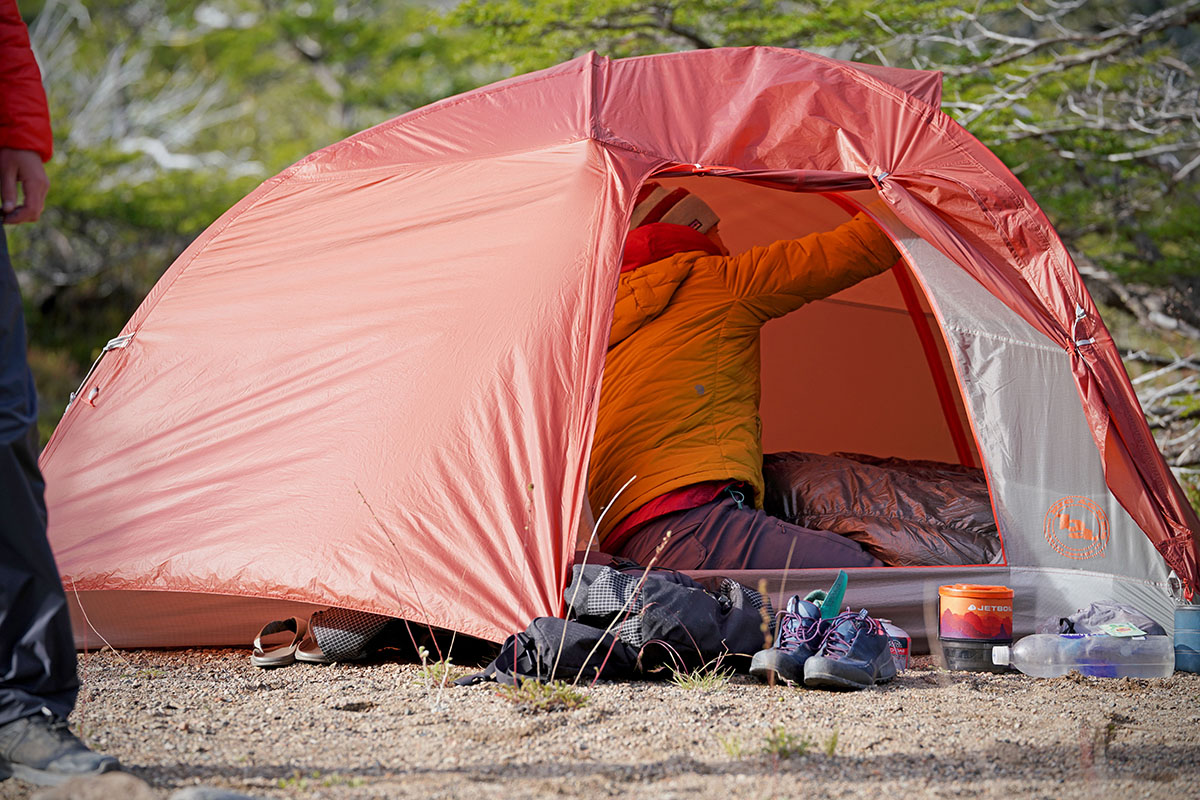
Another ultralight tent from Big Agnes is the Tiger Wall UL2, which blends pattern elements from the Copper Spur and Wing Creek lines. The Tiger Wall has two doors and vestibules and a center ridge pole like the Copper Spur, only its semi-freestanding layout trims weight fifty-fifty further. Compared with the Copper Spur, the Tiger Wall is lighter past 10 ounces and comes in $l cheaper (for more information, see our in-depth Tiger Wall review), but the Copper Spur is the i we prefer in most cases. Its freestanding construction is easier to prepare on just about any surface, the materials are more durable, and its pole design does a improve job opening upwards the interior. The Tiger Wall has a lot of appeal for solo trekkers and thru-hikers, but we recall the Copper Spur is the better accommodating choice, and especially for more than casual backpackers.
Outside of Big Agnes' lineup, REI's Quarter Dome SL 2 is a strong upkeep culling to the Copper Spur, which costs about $100 less while undercutting the Big Agnes in weight by four ounces. However, nosotros also tested the REI on our trip to Patagonia and constitute it to be noticeably tighter inside, and its mesh-heavy construction is more prone to letting in blowing dust. In addition, the semi-freestanding construction makes it more hard to set up on rocky surfaces, although it'due south still an all-around user-friendly design. In the finish, the Copper Spur'south improve livability makes it worth the added cost and weight for us, but both are well-balanced, lightweight backpacking tents.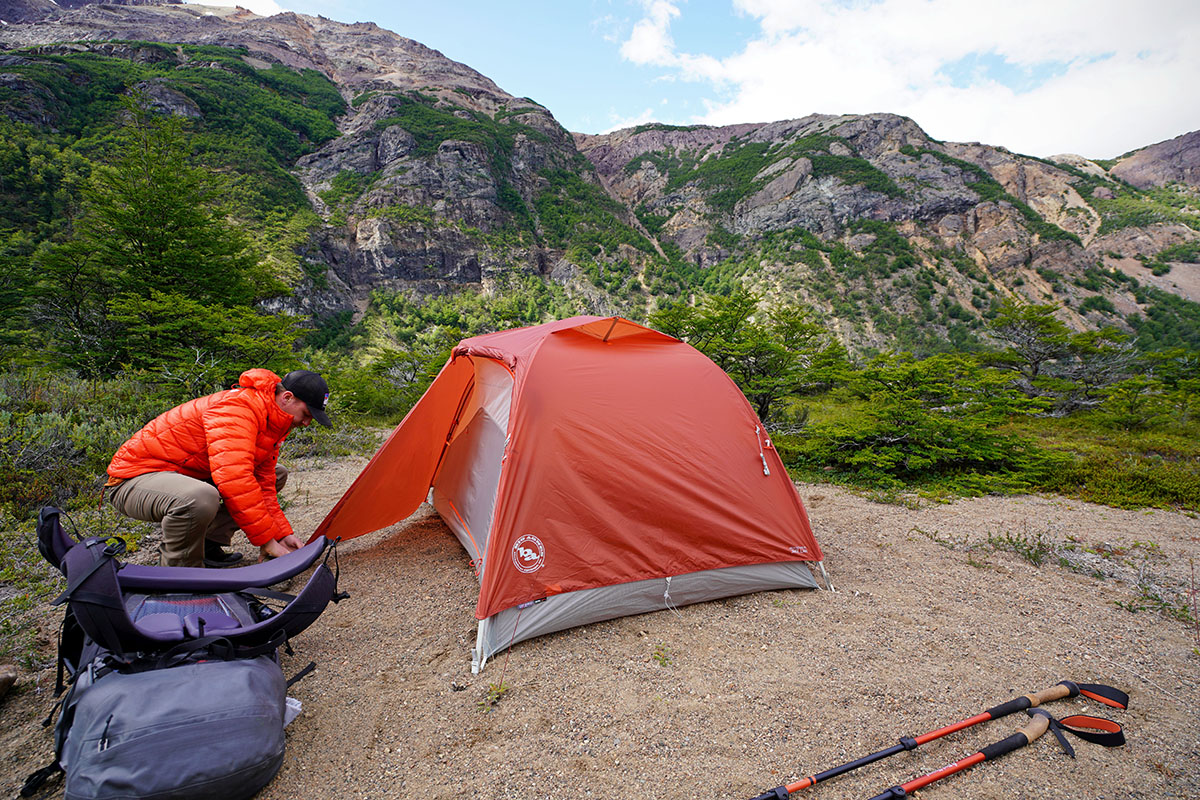
If you're willing to add a bit of weight to your pack, the Nemo Dagger 2P and MSR Hubba Hubba NX and are ii fantabulous backpacking models. We honey the more than durable fabrics that you get with the Nemo and MSR, and their symmetrical shapes mean you tin can sleep caput-to-toe for more room to motion around. As mentioned higher up, however, the Copper Spur beats them rather easily in weight (by 12 oz. for both). And perhaps most impressively, the Copper Spur pulls this off while retaining a double-wall, freestanding structure and two-door-and-vestibule pattern. All told, all three are solid options and meridian choices in our backpacking tent round-up, and a final conclusion will come up downwards to how y'all prioritize weight and space.
heidenreichates1941.blogspot.com
Source: https://www.switchbacktravel.com/reviews/big-agnes-copper-spur-hv-ul2
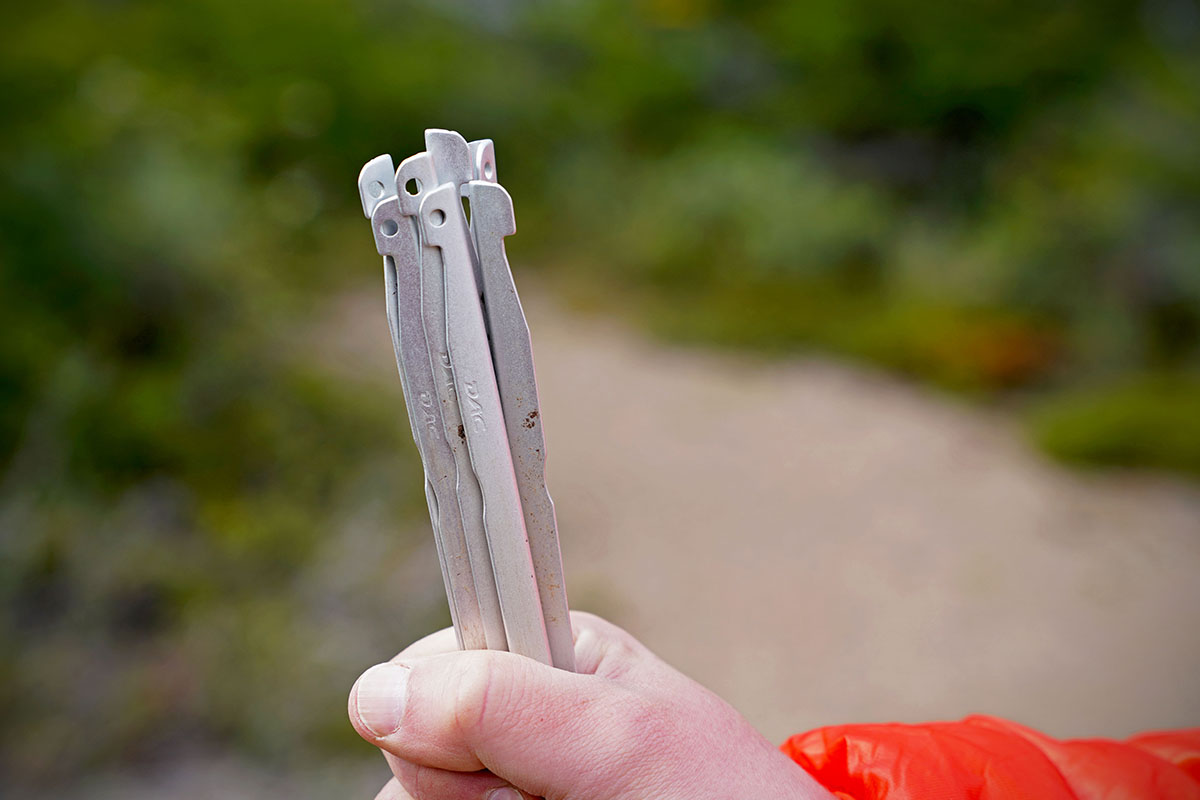
0 Response to "Big Agnes Copper Spur Ul 1 Mtnglo Review"
Post a Comment